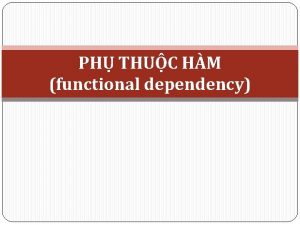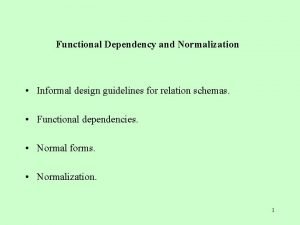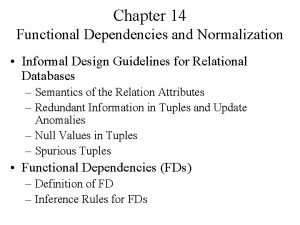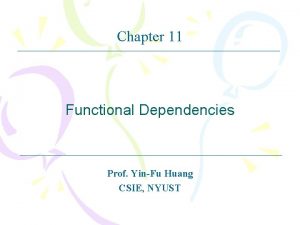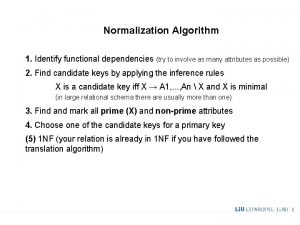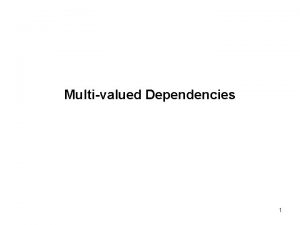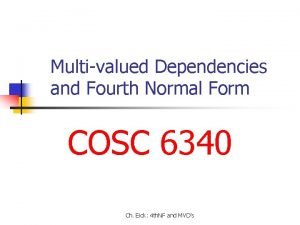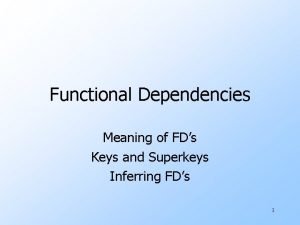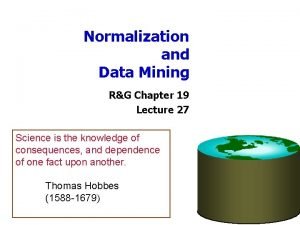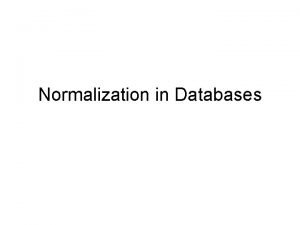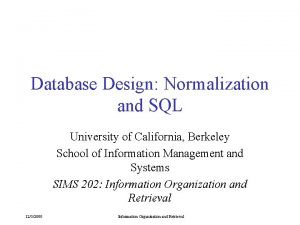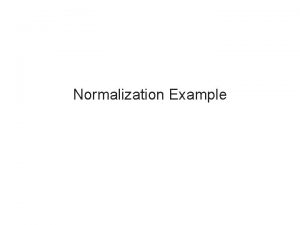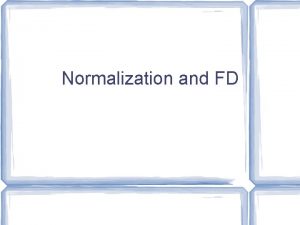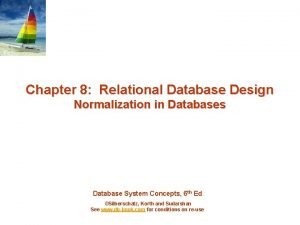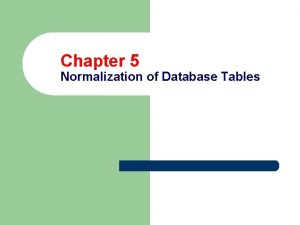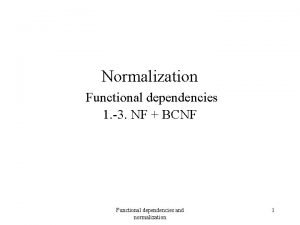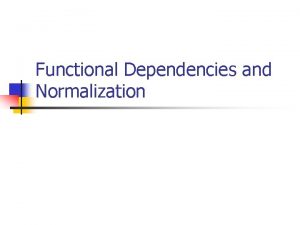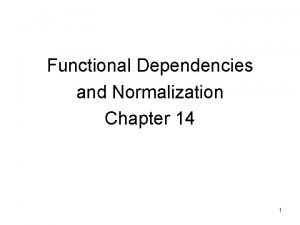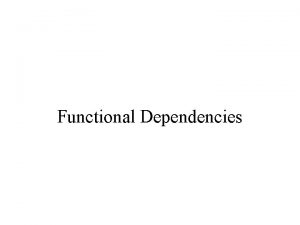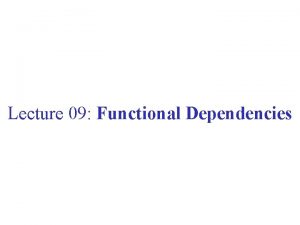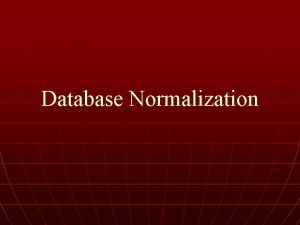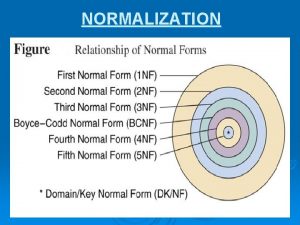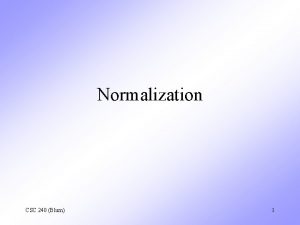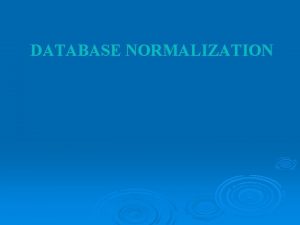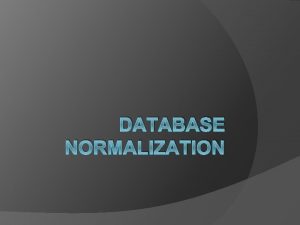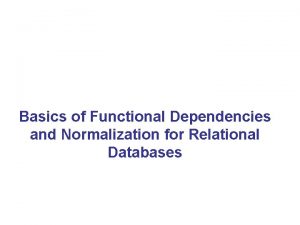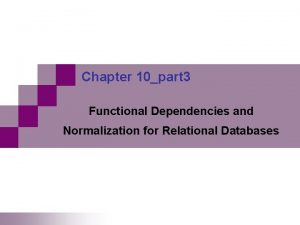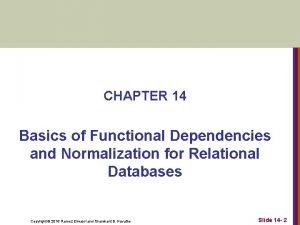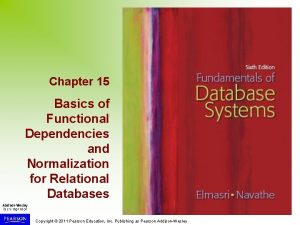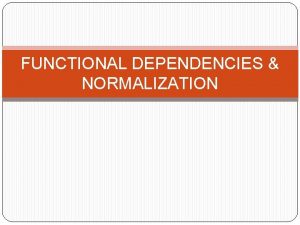DATA NORMALIZATION FUNCTIONAL DEPENDENCIES WELLSTRUCTURED RELATIONS A relation













































- Slides: 45

DATA NORMALIZATION FUNCTIONAL DEPENDENCIES

WELL-STRUCTURED RELATIONS • A relation that contains minimal data redundancy and allows users to insert, delete, and update rows without causing data inconsistencies • Goal is to avoid anomalies – Insertion Anomaly – adding new rows forces user to create duplicate data – Deletion Anomaly – deleting rows may cause a loss of data that would be needed for other future rows – Modification Anomaly – changing data in a row forces changes to other rows because of duplication General rule of thumb: a table should not pertain to more than one entity type 2 © Prentice Hall, 2002

DATA NORMALIZATION • Primarily a tool to validate and improve a logical design so that it satisfies certain constraints that avoid unnecessary duplication of data • The process of decomposing relations with anomalies to produce smaller, wellstructured relations 3 © Prentice Hall, 2002

EXAMPLE – FIGURE 5. 2 B Question – Is this a relation? Answer – Yes: unique rows and no Question – What’s the 4 multivalued attributes primary key? Answer – Composite: Emp_ID, Course_Title © Prentice Hall, 2002

ANOMALIES IN THIS TABLE • Insertion – can’t enter a new employee without having the employee take a class • Deletion – if we remove employee 140, we lose information about the existence of a Tax Acc class • Modification – giving a salary increase to employee 100 forces us to update multiple records 5 Why do these anomalies exist? Because we’ve combined two themes (entity types) into one relation. This results in duplication, and an unnecessary dependency © Prentice Hall, 2002 between the entities

NORMALIZATION TYPES We discuss four normal forms: first, second, third, and Boyce-Codd normal forms 1 NF, 2 NF, 3 NF, and BCNF Normalization is a process that “improves” a database design by generating relations that are of higher normal forms. The objective of normalization: “to create relations where every dependency is on the key, the whole key, and nothing but the key”. 91. 2914 6

NORMALIZATION There is a sequence to normal forms: 1 NF is considered the weakest, 2 NF is stronger than 1 NF, 3 NF is stronger than 2 NF, and BCNF is considered the strongest Also, any relation that is in BCNF, is in 3 NF; any relation in 3 NF is in 2 NF; and any relation in 2 NF is in 1 NF. 91. 2914 7

NORMALIZATION 1 NF a relation in BCNF, is also in 3 NF 2 NF a relation in 3 NF is also in 2 NF 3 NF a relation in 2 NF is also in 1 NF BCNF 91. 2914 8

NORMALIZATION We consider a relation in BCNF to be fully normalized. The benefit of higher normal forms is that update semantics for the affected data are simplified. This means that applications required to maintain the database are simpler. A design that has a lower normal form than another design has more redundancy. Uncontrolled redundancy can lead to data integrity problems. First we introduce the concept of functional dependency May 2005 91. 2914 9

FUNCTIONAL DEPENDENCIES AND KEYS • Functional Dependency: The value of one attribute (the determinant) determines the value of another attribute • Candidate Key: – A unique identifier. One of the candidate keys will become the primary key • E. g. perhaps there is both credit card number and SS# in a table…in this case both are candidate keys – Each non-key field is functionally dependent on every candidate key 10 © Prentice Hall, 2002

5. 22 -Steps in normalization 11 © Prentice Hall, 2002

FUNCTIONAL DEPENDENCIES Functional Dependencies We say an attribute, B, has a functional dependency on another attribute, A, if for any two records, which have the same value for A, then the values for B in these two records must be the same. We illustrate this as: A B Example: Suppose we keep track of employee email addresses, and we only track one email address for each employee. Suppose each employee is identified by their unique employee number. We say there is a functional dependency of email address on employee number: employee number email address 91. 2914 12

FUNCTIONAL DEPENDENCIES Emp. Num 123 456 555 633 787 Emp. Email jdoe@abc. com psmith@abc. com alee 1@abc. com pdoe@abc. com alee 2@abc. com Emp. Fname John Peter Alan Emp. Lname Doe Smith Lee Doe Lee If Emp. Num is the PK then the FDs: Emp. Num Emp. Email Emp. Num Emp. Fname Emp. Num Emp. Lname must exist. 91. 2914 13

FUNCTIONAL DEPENDENCIES Emp. Num Emp. Email Emp. Num Emp. Fname Emp. Num Emp. Lname Emp. Num 3 different ways you might see FDs depicted Emp. Email Emp. Fname Emp. Lname Emp. Num Emp. Email Emp. Fname 91. 2914 Emp. Lname 14

DETERMINANT Functional Dependency Emp. Num Emp. Email Attribute on the LHS is known as the determinant • Emp. Num is a determinant of Emp. Email 91. 2914 15

TRANSITIVE DEPENDENCY Transitive dependency Consider attributes A, B, and C, and where A B and B C. Functional dependencies are transitive, which means that we also have the functional dependency A C We say that C is transitively dependent on A through B. 91. 2914 16

TRANSITIVE DEPENDENCY Emp. Num Dept. Num Emp. Email Dept. Num Dept. Nname Dept. Num Dept. Name Emp. Num Emp. Email Dept. Num Dept. Nname Dept. Name is transitively dependent on Emp. Num via Dept. Num Emp. Num Dept. Name 91. 2914 17

PARTIAL DEPENDENCY A partial dependency exists when an attribute B is functionally dependent on an attribute A, and A is a component of a multipart candidate key. Inv. Num Line. Num Qty Inv. Date Candidate keys: {Inv. Num, Line. Num} Inv. Date is partially dependent on {Inv. Num, Line. Num} as Inv. Num is a determinant of Inv. Date and Inv. Num is part of a candidate key 91. 2914 18

FIRST NORMAL FORM First Normal Form We say a relation is in 1 NF if all values stored in the relation are single-valued and atomic. 1 NF places restrictions on the structure of relations. Values must be simple. 91. 2914 19

FIRST NORMAL FORM The following in not in 1 NF Emp. Num 123 333 679 Emp. Phone 233 -9876 233 -1231 Emp. Degrees BA, BSc, Ph. D BSc, MSc Emp. Degrees is a multi-valued field: employee 679 has two degrees: BSc and MSc employee 333 has three degrees: BA, BSc, Ph. D 91. 2914 20

FIRST NORMAL FORM Emp. Num 123 333 679 Emp. Phone 233 -9876 233 -1231 Emp. Degrees BA, BSc, Ph. D BSc, MSc To obtain 1 NF relations we must, without loss of information, replace the above with two relations. 91. 2914 21

FIRST NORMAL FORM Employee. Degree Employee Emp. Num 123 333 Emp. Phone 233 -9876 233 -1231 679 233 -1231 Emp. Num Emp. Degree 333 BA 333 BSc 333 Ph. D 679 BSc MSc An outer join between Employee and Employee. Degree will produce the information we saw before 91. 2914 22

SECOND NORMAL FORM • 1 NF plus every non-key attribute is fully functionally dependent on the ENTIRE primary key – Every non-key attribute must be defined by the entire key, not by only part of the key – No partial functional dependencies 23 © Prentice Hall, 2002

FIG 5. 23(B) – FUNCTIONAL DEPENDENCIES IN EMPLOYEE 2 Dependency on entire primary key Emp. ID Course. Title Name Dept. Nam Salar Date. Completed e y Dependency on only part of the key Emp. ID, Course. Title Date. Completed Emp. ID Name, Dept. Name, Salary Therefore, NOT in 2 nd Normal Form!! 24 © Prentice Hall, 2002

GETTING IT INTO 2 ND NORMAL FORM • Decomposed into two separate relations Emp. ID Name Dept. Nam Salar e y Both are full functional dependencie s Emp. ID Course. Titl Date. Completed e 25 © Prentice Hall, 2002

SECOND NORMAL FORM Consider this Inv. Line table (in 1 NF): Inv. Num Line. Num Inv. Num, Line. Num Prod. Num Qty Inv. Date Prod. Num, Qty There are two candidate keys. Qty is the only nonkey attribute, and it is Inv. Num Inv. Date dependent on Inv. Num Since there is a determinant that is not a candidate key, Inv. Line is not BCNF Inv. Line is not 2 NF since there is a partial only in 1 NF dependency of Inv. Date on Inv. Num 91. 2914 26

SECOND NORMAL FORM Inv. Line Inv. Num Line. Num Prod. Num Qty Inv. Date The above relation has redundancies: the invoice date is repeated on each invoice line. We can improve the database by decomposing the relation into two relations: Inv. Num Line. Num Inv. Date Prod. Num Qty Question: What is the highest normal form for these relations? 2 NF? 3 NF? BCNF? 91. 2914 27

Is the following relation in 2 NF? inv_no line_no prod_desc 91. 2914 qty 28

2 NF, but not in 3 NF, nor in BCNF: Employee. Dept ename ssn bdate address dnumber dname since dnumber is not a candidate key and we have: dnumber dname. 91. 2914 29

THIRD NORMAL FORM Third Normal Form • A relation is in 3 NF if the relation is in 1 NF and all determinants of nonkey attributes are candidate keys That is, for any functional dependency: X Y, where Y is a non-key attribute (or a set of non-key attributes), X is a candidate key. • This definition of 3 NF differs from BCNF only in the specification of non -key attributes - 3 NF is weaker than BCNF. (BCNF requires all determinants to be candidate keys. ) • A relation in 3 NF will not have any transitive dependencies of non-key attribute on a candidate key through another non-key attribute. 91. 2914 30

Figure 5 -24 -- Relation with transitive dependency (a) SALES relation with simple data 31 © Prentice Hall, 2002

Figure 5 -24(b) Relation with transitive dependency Cust. ID Name Cust. ID Salesperson Cust. ID Region All this is OK (2 nd NF) 32 BUT Cust. ID Salesperson Region Transitive dependency © Prentice Hall, 2002 (not 3 rd NF)

Figure 5. 25 -- Removing a transitive dependency (a) Decomposing the SALES relation 33 © Prentice Hall, 2002

Figure 5. 25(b) Relations in 3 NF Salesperson Region Cust. ID Name Cust. ID Salesperson Now, there are no transitive dependencies… Both relations are in 3 rd NF 34 © Prentice Hall, 2002

THIRD NORMAL FORM Consider this Employee relation Emp. Num Emp. Name Dept. Num Candidate keys are? … Dept. Name Emp. Name, Dept. Num, and Dept. Name are non-key attributes. Dept. Num determines Dept. Name, a non-key attribute, and Dept. Num is not a candidate key. Is the relation in 3 NF? … no Is the relation in BCNF? … no Is the relation in 2 NF? … yes 91. 2914 35

THIRD NORMAL FORM Emp. Num Emp. Name Dept. Num Dept. Name We correct the situation by decomposing the original relation into two 3 NF relations. Note the decomposition is lossless. Emp. Num Emp. Name Dept. Num Dept. Name Verify these two relations are in 3 NF. 91. 2914 36

OTHER NORMAL FORMS • Boyce-Codd NF – All determinants are candidate keys…there is no determinant that is not a unique identifier • 4 th NF – No multivalued dependencies • 5 th NF – No “lossless joins” • Domain-key NF – The “ultimate” NF…perfect elimination of all possible anomalies 37 © Prentice Hall, 2002

BOYCE-CODD NORMAL FORM (BCNF) – A table is in Boyce-Codd normal form (BCNF) if every determinant in the table is a candidate key. (A determinant is any attribute whose value determines other values with a row. ) – If a table contains only one candidate key, the 3 NF and the BCNF are equivalent. – BCNF is a special case of 3 NF.

A Table That Is In 3 NF But Not In BCNF

The Decomposition of a Table Structure to Meet BCNF Requirements

In 3 NF, but not in BCNF: Instructor teaches one course only. student_no course_no instr_no Student takes a course and has one instructor. {student_no, course_no} instr_no course_no since we have instr_no course-no, but instr_no is not a Candidate key. 91. 2914 41

student_no course_no instr_no BC NF student_no instr_no course_no instr_no {student_no, instr_no} student_no {student_no, instr_no} instr_no course_no 91. 2914 42

Sample Data for a BCNF Conversion

Decomposition into BCNF

DENORMALIZATION • Normalization is only one of many database design goals. • Normalized (decomposed) tables require additional processing, reducing system speed. • Normalization purity is often difficult to sustain in the modern database environment. The conflict between design efficiency, information requirements, and processing speed are often resolved through compromises that include denormalization.
 Functional dependencies and normalization
Functional dependencies and normalization Functional dependencies and normalization
Functional dependencies and normalization Informal design guidelines for relational schemas
Informal design guidelines for relational schemas Informal design definition
Informal design definition Irreducible set of functional dependencies
Irreducible set of functional dependencies Normalization example with solution
Normalization example with solution Ieee guide to software requirements specifications
Ieee guide to software requirements specifications Assumptions and dependencies example
Assumptions and dependencies example Multi valued dependencies
Multi valued dependencies Dependencies adrenalin ui
Dependencies adrenalin ui Multi valued dependency
Multi valued dependency Key dependencies meaning
Key dependencies meaning Acyclic dependencies principle
Acyclic dependencies principle Data transformation by normalization
Data transformation by normalization Data transformation by normalization
Data transformation by normalization Normalization in data mining
Normalization in data mining Microarray image analysis
Microarray image analysis Employee relations in public relations
Employee relations in public relations Semi fixed space maintainer
Semi fixed space maintainer Non functional plasma enzymes
Non functional plasma enzymes Enzymes in plasma
Enzymes in plasma Functional and non functional
Functional and non functional Normalization and weighting in lca
Normalization and weighting in lca Data characterization
Data characterization Spectral normalization gan
Spectral normalization gan Risk normalization examples
Risk normalization examples Primo ve normalization rules
Primo ve normalization rules Unnormalized data example
Unnormalized data example Purpose of normalization
Purpose of normalization Normalization of deviance ppt
Normalization of deviance ppt Alma normalization rules
Alma normalization rules Normalization in database
Normalization in database Normalization
Normalization Normalization constant
Normalization constant The purpose of normalization
The purpose of normalization Normalization process example
Normalization process example Purpose of normalization
Purpose of normalization Purpose of normalization
Purpose of normalization Section 8 database design
Section 8 database design Normalization of database tables
Normalization of database tables Normalization
Normalization Partial dependency normalization
Partial dependency normalization Normalization unf
Normalization unf Normalization
Normalization Objectives of normalization in database
Objectives of normalization in database Ist
Ist
